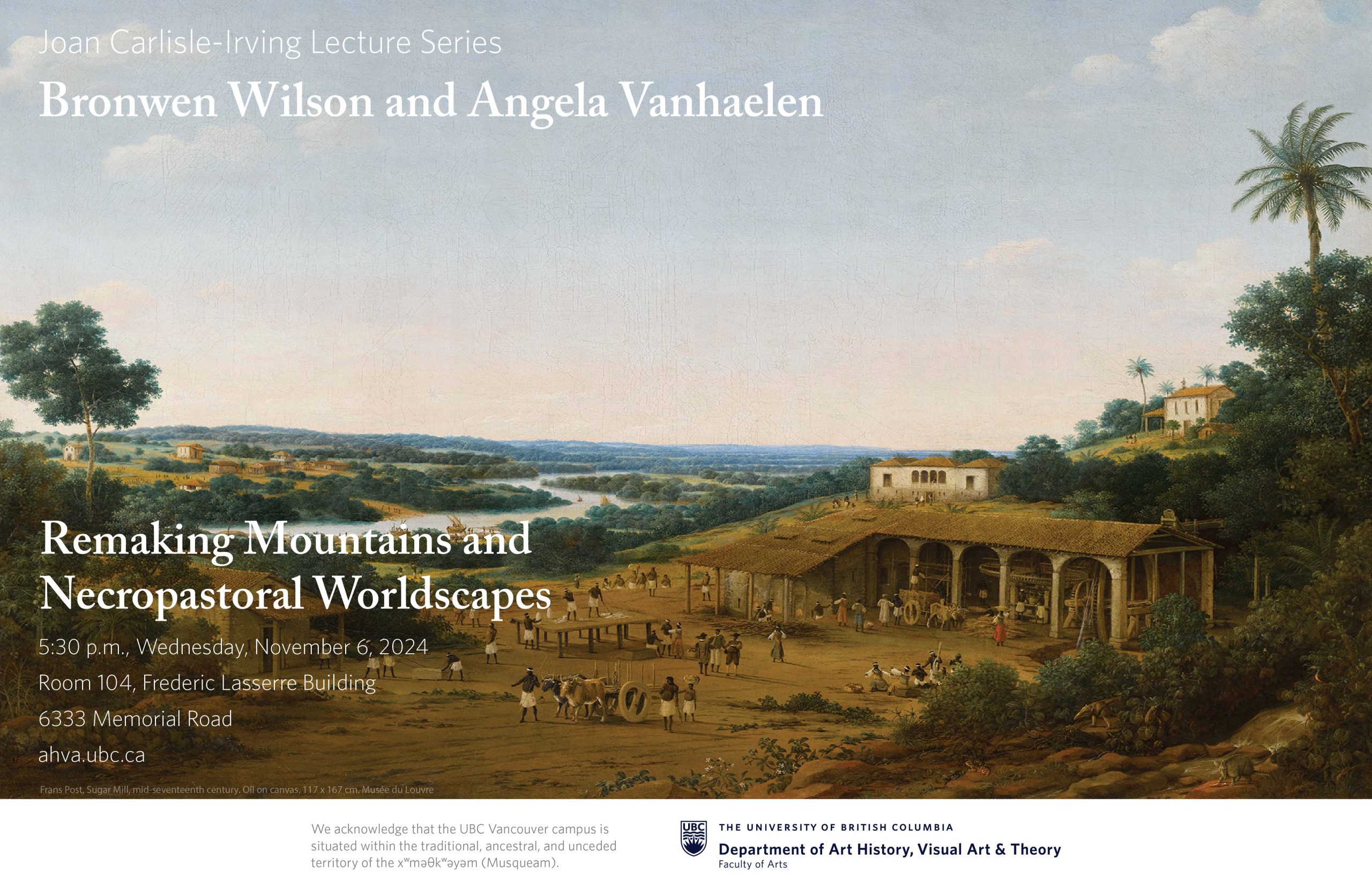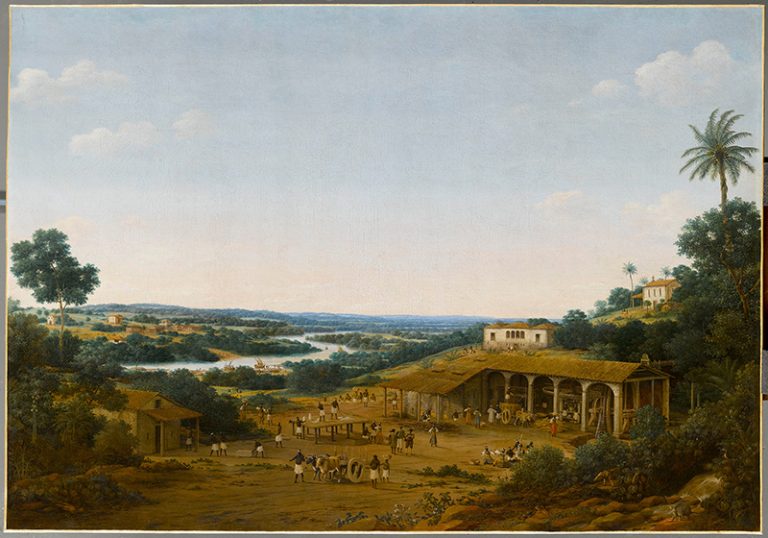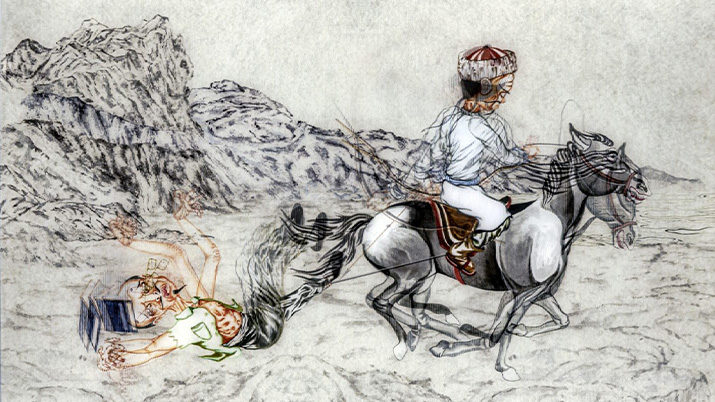A public talk by Bronwen Wilson and Angela Vanhaelen as part of the Joan Carlisle-Irving Lecture Series.
5:30 p.m., Wednesday, November 6, 2024
Room 104, Frederic Lasserre Building
6333 Memorial Road, University of British Columbia
ahva.ubc.ca
Please contact the AHVA Visual Resources Centre for access to the event recording: ahva.vrc@ubc.ca
Bronwen Wilson and Angela Vanhaelen have collaborated since their graduate student days at UBC. Their lectures will present aspects of their current collaborative project, Making Green Worlds: Early Modern Art and Ecologies of Globalization, which aims to re-assess the intersections of global mobility, environmental change, and artistic invention before the advent of the modern era.
Wilson’s lecture “Remaking Mountains” explores the dynamics of stone, bespoke printing, and vision in the Descrizione del Sacro Monte della Vernia, printed in 1612, probably in Florence. Rocky escarpments undulate across folio sheets designed to recreate the mountainous retreat of St Francis. Still perceived by some to be a living substance during the period, stone is a protagonist in the volume and in pietra dura (hard stone) designs highlighted in the talk, its otherworldly nature attesting to the inventive power of the earth.


Jacopo Ligozzi (designer) and Raffaello Schiaminossi (etcher), Detail of Plate A. ‘The following prospect shows how the mountain of Vernia appears close to a quarter mile while journeying from Casentino, noting the most important Places by the letters of the Alphabet, according to the promised order, which one will be observed in this Work, as in other parts of it’, in Fra Lino Moroni, Descrizione del Sacro Monte della Vernia (1612). Image: 58318751. Courtesy The New York Public Library, Digital Collections.
Vanhaelen’s lecture “Necropastoral Worldscapes” examines a series of plantation landscapes made in seventeenth-century colonial Dutch Brazil. Taking up the concept of the necropastoral, it investigates how these seemingly idyllic scenes indicate the enormous human and environmental devastation perpetuated by the forcible extraction of labour from enslaved African people and of sugar from the Atlantic Forest.
Bronwen Wilson teaches at UCLA, where she is Edward W. Carter Chair in European Art and the Director of the Center for 17th- and 18th-century Studies and the William Andrews Clark Memorial Library. She is Vice President of the Renaissance Society of America and serves on several editorial boards. Recent publications include an Introduction and edited collection of essays for the journal Viator, titled “On Early Modern Ships: Images, Metaphors, Bodies”; Conversion Machines in Early Modern Europe: Apparatus, Artifice, Body, edited with Paul Yachnin; and the essay, “Between the Skull and the Face: Jacopo Ligozzi and the Other Side of the Mirror,” was just published in the volume Physiognomy and Magic. Her book manuscript, The Horizons of Early Modern Mediterranean Travel Imagery: space, compass, conversion, is under consideration with Edinburgh University Press. The title of her current book project is Otherworldly Natures: lithic formations, in between spaces, and early modern Italian art.
Angela Vanhaelen is professor of art history in the Department of Art History and Communication Studies at McGill University in Montreal, Quebec, Canada. Her book Opacity. Blackness and the Art of the Dutch Republic is currently in production with Penn State University Press. She is also the author of The Moving Statues of 17th-century Amsterdam: Automata, Waxworks, Fountains, Labyrinths, published by Penn State in 2022. With Bronwen Wilson, she is principal investigator of the research initiative Making Green Worlds: Early Modern Art and Ecologies of Globalization, which is funded by the Social Sciences and Humanities Research Council of Canada. Vanhaelen’s 2012 book, The Wake of Iconoclasm: Painting the Church in the Dutch Republic was awarded the Bainton prize. She is also the author of Comic Print and Theatre in Early Modern Amsterdam: Gender, Childhood and the City, which developed out of the doctoral dissertation that she wrote while a PhD student here at UBC.
We acknowledge that the UBC Vancouver campus is situated on the traditional, ancestral, and unceded territory of the xʷməθkʷəy̓əm (Musqueam).




